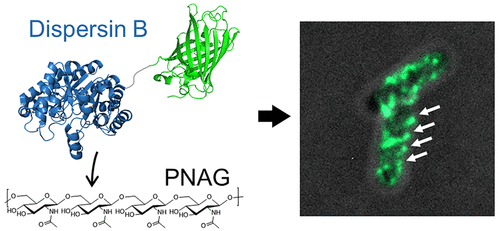当前位置:
X-MOL 学术
›
ACS Chem. Biol.
›
论文详情
Our official English website, www.x-mol.net, welcomes your feedback! (Note: you will need to create a separate account there.)
An Inactive Dispersin B Probe for Monitoring PNAG Production in Biofilm Formation.
ACS Chemical Biology ( IF 4 ) Pub Date : 2020-01-21 , DOI: 10.1021/acschembio.9b00907 Alexander Eddenden 1 , Elena N Kitova 2 , John S Klassen 2 , Mark Nitz 1
ACS Chemical Biology ( IF 4 ) Pub Date : 2020-01-21 , DOI: 10.1021/acschembio.9b00907 Alexander Eddenden 1 , Elena N Kitova 2 , John S Klassen 2 , Mark Nitz 1
Affiliation

|
The bacterial exopolysaccharide poly-β-1,6-N-acetylglucosamine is a major extracellular matrix component in biofilms of both Gram-positive and Gram-negative organisms. We have leveraged the specificity of the biofilm-dispersing glycoside hydrolase Dispersin B (DspB) to generate a probe (Dispersin B PNAG probe, DiPP) for monitoring PNAG production and localization during biofilm formation. Mutation of the active site of Dispersin B gave DiPP, which was an effective probe despite its low affinity for PNAG oligosaccharides (KD ∼ 1-10 mM). Imaging of PNAG-dependent and -independent biofilms stained with a fluorescent-protein fusion of DiPP (GFP-DiPP) demonstrated the specificity of the probe for the structure of PNAG on both single-cell and biofilm levels, indicating a high local concentration of PNAG at the bacterial cell surface. Through quantitative bacterial cell binding assays and confocal microscopy analysis using GFP-DiPP, discrete areas of local high concentrations of PNAG were detected on the surface of early log phase cells. These distinct areas were seen to grow, slough from cells, and accumulate in interbacterial regions over the course of several cell divisions, showing the development of a PNAG-dependent biofilm. A potential helical distribution of staining was also noted, suggesting some degree of organization of PNAG production at the cell surface prior to cell aggregation. Together, these experiments shed light on the early stages of PNAG-dependent biofilm formation and demonstrate the value of a low-affinity-high-specificity probe for monitoring the production of bacterial exopolysaccharides.
中文翻译:

用于监测生物膜形成中PNAG产生的非活性Dispersin B探针。
细菌胞外多糖聚-β-1,6-N-乙酰氨基葡萄糖是革兰氏阳性和革兰氏阴性生物的生物膜中的主要细胞外基质成分。我们已经利用分散生物膜的糖苷水解酶Dispersin B(DspB)的特异性来生成探针(Dispersin B PNAG探针,DiPP),用于监测生物膜形成过程中PNAG的产生和定位。分散素B活性位点的突变产生了DiPP,尽管它对PNAG寡糖的亲和力低(KD约为1-10 mM),但它是一种有效的探针。用DiPP荧光蛋白融合物(GFP-DiPP)染色的PNAG依赖性和非依赖性生物膜的成像表明,探针在单细胞和生物膜水平上对PNAG结构的特异性,表明PNAG的局部浓度很高在细菌细胞表面。通过定量细菌细胞结合测定和使用GFP-DiPP的共聚焦显微镜分析,在早期对数期细胞表面检测到局部高浓度PNAG的离散区域。这些不同的区域可以从细胞中脱落,脱落,并在几个细胞分裂过程中在细菌间区域积聚,显示出PNAG依赖性生物膜的发展。还指出了潜在的染色螺旋分布,这表明在细胞聚集之前,PNAG产生在细胞表面有一定程度的组织。总之,这些实验揭示了PNAG依赖性生物膜形成的早期阶段,并证明了低亲和力高特异性探针对监测细菌胞外多糖产生的价值。
更新日期:2020-01-09
中文翻译:

用于监测生物膜形成中PNAG产生的非活性Dispersin B探针。
细菌胞外多糖聚-β-1,6-N-乙酰氨基葡萄糖是革兰氏阳性和革兰氏阴性生物的生物膜中的主要细胞外基质成分。我们已经利用分散生物膜的糖苷水解酶Dispersin B(DspB)的特异性来生成探针(Dispersin B PNAG探针,DiPP),用于监测生物膜形成过程中PNAG的产生和定位。分散素B活性位点的突变产生了DiPP,尽管它对PNAG寡糖的亲和力低(KD约为1-10 mM),但它是一种有效的探针。用DiPP荧光蛋白融合物(GFP-DiPP)染色的PNAG依赖性和非依赖性生物膜的成像表明,探针在单细胞和生物膜水平上对PNAG结构的特异性,表明PNAG的局部浓度很高在细菌细胞表面。通过定量细菌细胞结合测定和使用GFP-DiPP的共聚焦显微镜分析,在早期对数期细胞表面检测到局部高浓度PNAG的离散区域。这些不同的区域可以从细胞中脱落,脱落,并在几个细胞分裂过程中在细菌间区域积聚,显示出PNAG依赖性生物膜的发展。还指出了潜在的染色螺旋分布,这表明在细胞聚集之前,PNAG产生在细胞表面有一定程度的组织。总之,这些实验揭示了PNAG依赖性生物膜形成的早期阶段,并证明了低亲和力高特异性探针对监测细菌胞外多糖产生的价值。



























 京公网安备 11010802027423号
京公网安备 11010802027423号